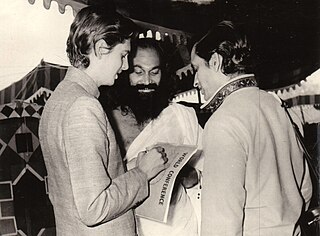
Sikhism, also known as Sikhi, is an Indian religion and philosophy in particular for the Sikh ethnoreligious group that originated in the Punjab region of India around the end of the 15th century CE. The Sikh scriptures are written in the Gurumukhi script particular to Sikhs. It is one of the most recently founded major religious groups and among the largest in the world, with about 25–30 million adherents.

Kundalini yoga derives from kundalini, defined in tantra as energy that lies within the body, frequently at the navel or the base of the spine. In normative tantric systems, kundalini is considered to be dormant until it is activated and channeled upward through the central channel in a process of spiritual perfection. Other schools, such as Kashmir Shaivism, teach that there are multiple kundalini energies in different parts of the body which are active and do not require awakening. Kundalini is believed by adherents to be power associated with the divine feminine, Shakti. Kundalini yoga as a school of yoga is influenced by Shaktism and Tantra schools of Hinduism. It derives its name through a focus on awakening kundalini energy through regular practice of mantra, tantra, yantra, yoga, laya, haṭha, meditation, or even spontaneously (sahaja).

Guru Gobind Singh was the tenth and last human Sikh Guru. He was a warrior, poet, and philosopher. In 1675, at the age of nine he was formally installed as the leader of the Sikhs after his father Guru Tegh Bahadur was executed by Emperor Aurangzeb. His father was the ninth Sikh Guru. His four biological sons died during his lifetime – two in battle and two executed by the Mughal governor Wazir Khan.

The Guru Granth Sahib is the central holy religious scripture of Sikhism, regarded by Sikhs as the final, sovereign and eternal Guru following the lineage of the ten human gurus of the religion. The Adi Granth, its first rendition, was compiled by the fifth guru, Guru Arjan (1564–1606). Its compilation was completed on 29 August 1604 and first installed inside the Golden Temple in Amritsar on 1 September 1604. Baba Buddha was appointed the first Granthi of the Golden Temple. Shortly afterwards Guru Hargobind added Ramkali Ki Vaar. Later, Guru Gobind Singh, the tenth Sikh guru, added hymns of Guru Tegh Bahadur to the Adi Granth and affirmed the text as his successor. This second rendition became known as the Guru Granth Sahib and is also sometimes referred to as the Adi Granth.

Khalsa refers to both a community that considers Sikhism as its faith, as well as a special group of initiated Sikhs. The Khalsa tradition was initiated in 1699 by the Tenth Guru of Sikhism, Guru Gobind Singh. Its formation was a key event in the history of Sikhism. The founding of Khalsa is celebrated by Sikhs during the festival of Vaisakhi.

Harbhajan, popularly known as Yogi Bhajan and Siri Singh Sahib to his followers, was an Indian-born American entrepreneur, yoga guru, and spiritual teacher. He introduced his version of Kundalini yoga to the United States. He was the spiritual director of the 3HO foundation, with over 300 centers in 35 countries. He was accused of sexual abuse by several dozen of his female followers; an investigation called the Olive Branch Report found the allegations most likely true.

Yogi Tea is an American brand offering organic herbal, green and black tea blends. The company is privately held and operated in North America by East West Tea Company, LLC and YOGI TEA GmbH for Europe.

Dhirendra Brahmachari, born Dhirendra Choudhary in village Basaith Chanpura, Madhubani, Bihar, was a yoga teacher of Yogi Bhajan who taught Kundalini Yoga in the West and founded 3HO. Dhirendra Brahmachari was also yoga mentor of Indira Gandhi –The former prime minister of India He ran ashrams in Bhondsi, Jammu, Katra and Mantalai and wrote books on yoga.

Snatam Kaur Khalsa, is an American singer, songwriter and author. Kaur performs new age Indian devotional music, kirtan, and tours the world as a peace activist. The surname "Kaur", meaning "princess", is shared by all female Sikhs.
Gurmukh Kaur Khalsa is a teacher of Kundalini yoga, as taught by Yogi Bhajan, and a pioneer in the field of pre-natal yoga. She is the co-founder and director of the Golden Bridge Yoga Center in Los Angeles, and the author of two books and three DVDs. She has become a yoga guru for Hollywood film stars.
Laura Drew, a.k.a. Singh Kaur or Lorellei (1955–1998) was a new-age music composer, vocalist and instrumentalist, who had a prolific career that lasted from the early 1970s to the late 1990s, releasing 23 albums. With her angelic voice and haunting melodies, Singh Kaur was a pioneer in the growing genre of Western interpretations of Indian chanting music.
Satkirin Kaur Khalsa is a Sikh preacher and prolific Sikh Kirtan singer. She hosts a Kundalini Yoga show on the JUS Punjabi television channel.
Babaji Singh Khalsa was a Mexican Sikh who is credited for translating Guru Granth Sahib, the holy text of the Sikhs into Spanish.
Sikhism has often been criticised by non-Sikhs regarding its texts, practices, and societal norms, but Sikhs and other scholars argue that these criticisms are flawed and are based on a biased and poor understanding of the texts, especially of the multiple languages used in the Sikh scriptures. They also argue that most western scholars who attempted to interpret eastern religious texts were missionaries and could not overcome the bias they carried with them, irrespective of whether they were translating the Quran, Vedas, Puranas or the Guru Granth Sahib. Guru Nanak rejected ritualistic worship and encouraged belief in one true God, Waheguru. The veneration and bowing to the Guru Granth Sahib, has often been interpreted by western scholars as akin to idolatry, as observed by the Hindu faith, which defeats the ideology of Guru Nanak. Other scholars dismiss Sikhism as, either consciously or spontaneously, a syncretism of the Hindu Bhakti and Muslim Sufi movements.
Krishna Kaur Khalsa is an American teacher of Kundalini Yoga as per the teachings of Yogi Bhajan. Born Thelma Oliver, she initially pursued a career as an actress in films and theater. In 1970, she shifted her focus to empowering others through the practice of yoga.

Sikh sects, denominations, traditions, movements, sub-traditions, also known as sampardai in the Punjabi language, are sub-traditions within Sikhism that believe in different approaches to practicing the religion. All sampradas believe in the One Creator God typically rejecting both idol worship and caste systems. Different interpretations have emerged over time, some of which have a living teacher as the leader. The major historic traditions in Sikhism, states Harjot Oberoi, have included Udasi, Nirmala, Nanakpanthi, Khalsa, Sahajdhari, Namdhari Kuka, Nirankari and Sarvaria.

Sexual abuse by yoga gurus is the exploitation of the position of trust occupied by a master of any branch of yoga for personal sexual pleasure. Allegations of such abuse have been made against modern yoga gurus such as Bikram Choudhury, Kausthub Desikachar, Yogi Bhajan, Amrit Desai, and K. Pattabhi Jois. There have been some criminal convictions and lawsuits for civil damages.
The Sikh Gurdwara of Eugene, also known as Guru Ram Das Gurdwara, is a Sikh ashram community in Eugene, Oregon founded in 1970 by Yogi Bhajan sent Sat Kirpal Singh.
GURU JAGAT born Katie Griggs, was a celebrated and iconoclastic thought leader, teacher, poet, author, fashion designer, musician, and entrepreneur. She founded RA MA Institute for Applied Yogic Science and Technology in 2013, as a platform for sharing Kundalini yoga and meditation. In 2014, Guru Jagat launched RA MA TV bringing her classes, trainings, courses, and open access content to students around the world.















